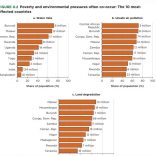Mozambique: EUMAM MOZ on World Cleanup Day 2025
Mozambique: WMO declares La Nina event for second year running – AIM

Probabilistic forecasts of surface air temperature for December-February 2021-2022. The baseline period is 1993–2009. Figure is generated by The WMO Lead Centre for Long-Range Forecast Multi-Model Ensemble. [Source: WMO]
The United Nations’ World Meteorological Organisation (WMO) has declared that a La Nina weather phenomenon has developed for the second year in succession, albeit that it is likely to be a weak to moderate event.
La Nina is the opposite of the better-known El Nino phenomenon. El Nino refers to higher than usual surface water temperatures in the eastern central Pacific, whereas in a La Nina period, the surface water temperature in the Pacific drops by three degrees or more. Both events can have a major impact on rainfall patterns and in the past La Nina has been associated with an increased number of cyclones and excessive rain in the south and centre of Mozambique.

The World Meteorological Organisation pointed out that despite the cooling impact of the previous La Nina, 2021 will be “one of the ten warmest years on record, rather than THE warmest year”. According to its Secretary-General, Professor Petteri Taalas, “this is a short-lived respite and does not reverse the long-term warming trend or reduce the urgency of climate action”.
The big temperature divide
As we start the meteorological winter/summer, vast regions of the world are unusually warm or cold
Map of average 2m temperature anomalies from https://t.co/f514RCrePLhttps://t.co/VIFSkGyxnS pic.twitter.com/XazKxfy2Tr— World Meteorological Organization (@WMO) December 2, 2021
WMO Global Seasonal Outlook and #LaNiña Update:
Above average temperatures forecast for many land areas
eg Far northern and NE parts of #Asia and #Arctic, E and SE North America, Caribbean
Exceptions include NW North America, Indian subcontinent. https://t.co/RA4EufZOCM pic.twitter.com/VNpvOypOlF— World Meteorological Organization (@WMO) November 30, 2021
For the 2nd consecutive year, #LaNiña has developed, and will impact rainfall and temperatures
Despite cooling influence of #LaNiña, many parts of the world are expected to be warmer than average because of #climatechange, per new WMO Updatehttps://t.co/RA4EufZOCM pic.twitter.com/evGZZhLAcd
— World Meteorological Organization (@WMO) November 30, 2021












Leave a Reply
Be the First to Comment!
You must be logged in to post a comment.
You must be logged in to post a comment.